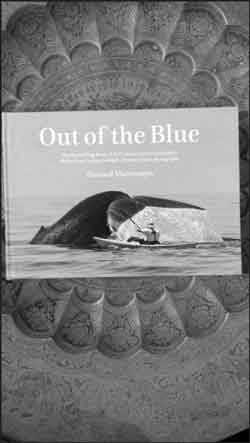Tuesday Mar 18, 2025
Tuesday Mar 18, 2025
Saturday, 2 February 2019 00:00 - - {{hitsCtrl.values.hits}}
 Travelling beyond Lanka’s shores, one soon realises that we are blessed with a super-abundance of nature. Trees, Birds, Animals, Insects – Lanka attracts them all and we seem blessed with a higher proportion than anyone else. Much as we thrill to the sight of an elephant, leopard or bear, or even nature’s general accessibility on land, there is another dimension we rarely explore – the ocean that surrounds us, that is literally teeming with molluscs, fish, mammals and plants of all sorts.
Travelling beyond Lanka’s shores, one soon realises that we are blessed with a super-abundance of nature. Trees, Birds, Animals, Insects – Lanka attracts them all and we seem blessed with a higher proportion than anyone else. Much as we thrill to the sight of an elephant, leopard or bear, or even nature’s general accessibility on land, there is another dimension we rarely explore – the ocean that surrounds us, that is literally teeming with molluscs, fish, mammals and plants of all sorts.
Given our increasing leisure time, Lankans are fast becoming Lanka’s favourite tourists and as local sight-seers, we want to be gratified with something new every day. Once we are done with our famed archaeology and game parks, we must look further afield. But no need to travel far – our oceans play host to the world’s largest mammals – dolphins, whales, dugongs and porpoises abound and even though many of them are on the endangered species list, sightings relatively close to the coast will not disappoint. Surprisingly, very few of us have seen many or any of these giants of the seas, who remain an unknown quantity to the greater population.
Giants of the seas, you ask sceptically. How big can a whale be? Without exaggeration, a blue whale is about the size of 20 adult elephants and a sperm whale is about the size of 30 full-grown elephants – imagine that! Aha, and now that I’ve got your attention and interest, you want to know where you can see them; whether they can they be photographed and whether they are dangerous? When do they sleep and what is the best time to see them?
Before you rush to the nearest beach and hop onto the first available boat that will take you into the wild blue yonder, get yourself a copy of Howard Martenstyn’s superb, recently updated book Out of the Blue which is chock-full of information and details on all of these mammals and which answers in lay terms every question that could cross an uninitiated mind. Besides information on habitat, feeding, migration, etc., the book has a fascinating assortment of photographs and illustrations which will give you an insider’s idea of how these spectacular mammals look in their full and complete form. Keep in mind that quite often, when you are in a small boat, chasing behind a big whale, all you will see is his tail or blowhole. If you read the book attentively, you might impress your friends and family by identifying what type of whale the tail belongs to.
While chasing after marine big game, we must remember that our tropical seas will also reveal a surprisingly large population of dolphins and even if we don’t see a whale on our first trip out, the chances are good that we will run into a shoal of these gentle marine mammals who will race alongside and under our boat, within touching distance.
Dolphins are often identified by their humps or fins and are always a rewarding sight. On occasions when spinner dolphins leap completely out of  the water and spin like a top before plunging back in, you will be so mesmerised by the performance that you may forget to photograph them. Then again, some of these sights are so rare that you would be better off enjoying the show and committing it to memory rather than trying to record it for posterity.
the water and spin like a top before plunging back in, you will be so mesmerised by the performance that you may forget to photograph them. Then again, some of these sights are so rare that you would be better off enjoying the show and committing it to memory rather than trying to record it for posterity.
For all its hidden and revealed beauty, the ocean is never as calm as a swimming pool and if getting sea-sick on choppy seas in a small outboard isn’t for you, the author Howard Martenstyn organises small plane rides which makes spotting marine mammals easier. Not only would this enable you to keep a safe distance from danger, it is a treat worth saving up for when you take the plunge and head into the blue.
(Sam Perera is a partner of the Perera-Hussein Publishing House which publishes culturally relevant stories by emerging and established Lankan and regional authors – for a primarily Lankan audience. Ph books are available everywhere books are sold and through www.pererahussein.com.)
Discover Kapruka, the leading online shopping platform in Sri Lanka, where you can conveniently send Gifts and Flowers to your loved ones for any event including Valentine ’s Day. Explore a wide range of popular Shopping Categories on Kapruka, including Toys, Groceries, Electronics, Birthday Cakes, Fruits, Chocolates, Flower Bouquets, Clothing, Watches, Lingerie, Gift Sets and Jewellery. Also if you’re interested in selling with Kapruka, Partner Central by Kapruka is the best solution to start with. Moreover, through Kapruka Global Shop, you can also enjoy the convenience of purchasing products from renowned platforms like Amazon and eBay and have them delivered to Sri Lanka.
Discover Kapruka, the leading online shopping platform in Sri Lanka, where you can conveniently send Gifts and Flowers to your loved ones for any event including Valentine ’s Day. Explore a wide range of popular Shopping Categories on Kapruka, including Toys, Groceries, Electronics, Birthday Cakes, Fruits, Chocolates, Flower Bouquets, Clothing, Watches, Lingerie, Gift Sets and Jewellery. Also if you’re interested in selling with Kapruka, Partner Central by Kapruka is the best solution to start with. Moreover, through Kapruka Global Shop, you can also enjoy the convenience of purchasing products from renowned platforms like Amazon and eBay and have them delivered to Sri Lanka.